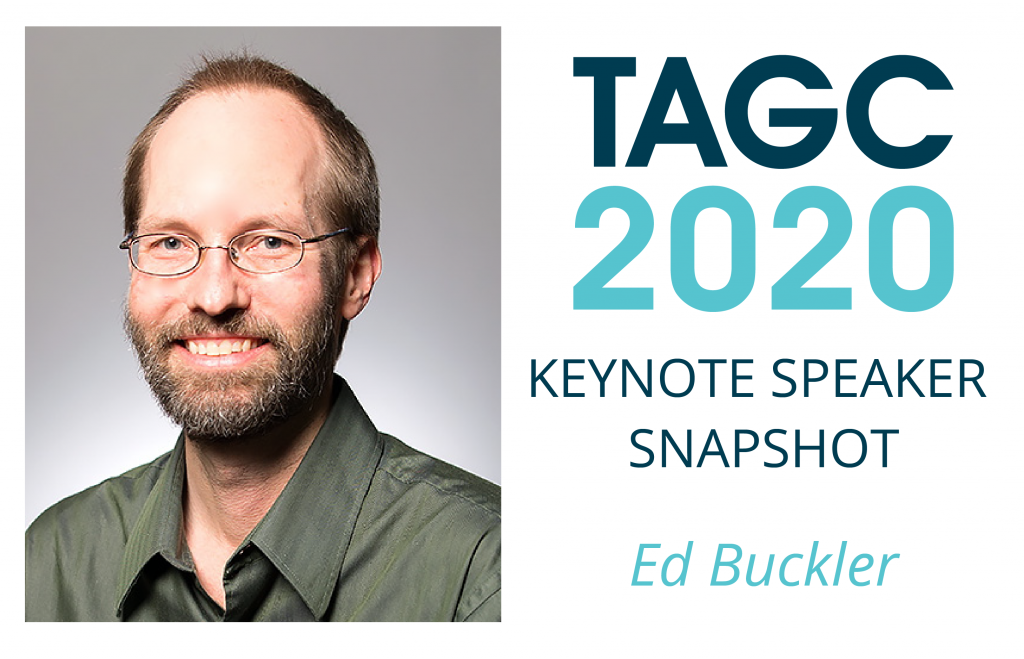Get to know the TAGC 2020 Keynote Speakers through our interview series.

Ed Buckler
Edward S. Buckler is a Research Geneticist with the USDA-ARS and an Adjunct Professor of Plant Breeding and Genetics at Cornell University. He began his career studying molecular evolution and archaeology, which got him interested in using natural diversity to improve crops and increase sustainability. Buckler developed association mapping approaches and germplasm to pinpoint genes and find natural variation controlling many maize traits. His group has also developed a wide range of big data, bioinformatic, and molecular tools that have been used to characterize and tap diversity in over 2,000 species. Currently, his group is developing approaches to use multiple sources of biological knowledge to design sustainable, energy-efficient crops that are adapted to numerous environments. Buckler has many leadership positions within the crop and genetics communities and is a member of the National Academy of Sciences.
What research are you most excited about right now, and why?
I’m most excited about the ability to use machine learning approaches on very fundamental molecular biology data. We’re starting to be able to model transcription and translation and to take those models and start applying them to a wide variety of species and crops. We have the opportunity to take detailed data about how molecular biology and biochemistry work and to apply it very quickly to crops in the field, to conservation biology problems, and to many other areas.
What do you like about working with crops?
I think some of the biggest challenges facing the globe today have to do with how we interact with the environment—whether that’s climate change or how we produce our food. Crops provide us an opportunity to use advances in genetics to address some of these societal and environmental goals. We get to do really cool genetics and then see the application very quickly, whether that’s feeding people in the developing world or thinking about how we can sequester carbon.
Is there anything about yourself or the field that made you feel like you didn’t belong in science? What would you say to early career scientists struggling with the same feeling?
Personally, I was always encouraged to go into science. But my work has taught me that we need diversity of experience in science. The range of expertise we need to make real progress in solving questions about how we produce food systems is very wide. We need to work in diverse teams to think all the way through the implications of our research and to start asking the right questions about how to apply genetics. The only way we get the diversity of ideas we need is by having a diversity of people, which allows us to even think of the right questions to ask. So I would say to anyone who isn’t sure they fit in science: we need you, your individual experiences, and your unique viewpoint.
TAGC aims to foster collaboration between communities and disciplines. Can you give an example of a collaboration that really helped your work?
One of the first and earliest collaborations started because a colleague of mine raised the question: “Is there a way we could identify genes controlling provitamin A content in maize?” At the time, association mapping was just starting to look like it would work, so I said, “Yeah, I think we can do that.” In a very short period of time, we were able to identify a few of the key genes and genetic variants that were responsible for provitamin A content, allowing breeders to quickly select for a 20- to 30-fold increase. Following that initial scientific discovery, it took coordinated teams of people working across East Africa and Mexico to get the technology deployed. The basic discovery only took a short time, but it took another five to seven years to see the effects of that discovery out in the field. It really does take working together to make the transition from basic to applied science happen.
Select Publications from the Buckler Lab
A unified mixed-model method for association mapping that accounts for multiple levels of relatedness
Yu J, Pressoir G, Briggs WH, Bi IV, Yamasaki M, Doebley JF, McMullen MD, Gaut BS, Holland JB, Kresovich S, Buckler ES
Nature Genetics. 2006 Feb;38(2):203-8. doi: 10.1038/ng1702
A robust, simple genotyping-by-sequencing (GBS) approach for high diversity species
Elshire RJ, Glaubitz JC, Sun Q, Poland JA, Kawamoto K, Buckler ES, Mitchell SE
PLoS One. 2011 May 4;6(5):e19379. doi: 10.1371/journal.pone.0019379
A study of allelic diversity underlying flowering-time adaptation in maize landraces
Romero-Navarro JA, Willcox M, Burgueño J, Romay MC, Swarts KL, Trachsel S, Preciado E, Terron A, Delgado HV, Vidal V, Ortega A, Ortiz-Monasterio I, Vincente FS, Atlin G, Wenzl P, Hearne S, Buckler ES
Nature Genetics. 2017 Mar;49(3):476-480. doi: 10.1038/ng.3784
Dysregulation of expression correlates with rare-allele burden and fitness loss in maize
Kremling KA, Chen SY, Su MH, Lepak NK, Romay MC, Swarts KL, Lu F, Lorant A, Bradbury PJ, Buckler ES
Nature. 2018 Mar 22;555(7697):520-523. doi: 10.1038/nature25966
Evolutionarily informed deep learning methods for predicting relative transcript abundance from DNA sequence
Washburn JD, Mejia-Guerra MK, Ramstein G, Kremling KA, Valluru R, Buckler ES, Wang H
PNAS. 2019 Mar 19;116(12):5542-5549. doi: 10.1073/pnas.1814551116.













